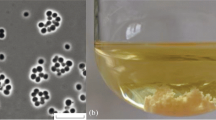Abstract
A single strain of a budding bacterium was isolated from freshwater. The strain had a life-cycle, with a multitrichous swarmer stage, and produced a phase-dark inclusion of packed ribosomes and nuclear material. The mol % G+C of the DNA was 64.4±1.0. A new genus,Gemmata with the type speciesGemmata obscuriglobus is proposed. The type strain is UQM 2246.
Similar content being viewed by others
References
DoelleH. W. 1975. Bacterial Metabolism, Second edition. — Academic Press Inc., New York.
FranzmannP. D. and SkermanV. B. D. 1981.Agitococcus lubricus gen. nov. sp. nov., a lipolytic, twitching coccus from freshwater. — Int. J. Syst. Bacteriol.31: 177–183.
HenriciA. T. and JohnsonD. E. 1935. Studies of freshwater bacteria II. Stalked bacteria, a new order of Schizomycetes. — J. Bacteriol.30: 61–93.
HirschP. 1972. Re-evaluation ofPasteuria ramosa Metchnikoff 1888, a bacterium pathogenic forDaphnia species. — Int. J. Syst. Bacteriol.22: 112–116.
HughR. and LeifsonE. 1953. The taxonomic significance of fermentative versus oxidative metabolism of carbohydrates by various gram negative bacteria. — J. Bacteriol.66: 24–26.
LuftJ. H. 1971. Ruthenium red and violet. I. Chemistry, purification methods of use for electron microscopy and mechanism of action. — Anat. Rec.17: 347–368.
MarmurJ. 1961. A procedure for the isolation of deoxyribonucleic acid from microorganisms. — J. Mol. Biol.3: 208–218.
MarmurJ. and DotyP. 1962. Determination of base composition of deoxyribonucleic acid from its thermal denaturation temperature. — J. Mol. Biol.5: 109–118.
MetchnikoffM. E. 1888.Pasteuria ramosa, un représentant des bactéries à division longitudinale. — Ann. Inst. Pasteur, Paris2: 165–170.
PringsheimE. G. 1946. Pure Cultures of Algae. — Cambridge University Press, Cambridge.
SayreR. M., AdamsJ. R. and WerginW. P. 1979. Bacterial parasite of a cladoceran: morphology, development in vivo, and taxonomic relationships withPasteuria ramosa Metchnikoff 1888. —Int. J. Syst. Bacteriol.29: 252–262.
SkermanV. B. D. 1967. A Guide to the Identification of the Genera of Bacteria, Second edition. — The Williams and Wilkins Co., Baltimore.
SkermanV. B. D. 1968. A new type of micromanipulator and microforge. — J. Gen. Microbiol.54: 287–297.
SkermanV. B. D., McGowanV. and SneathP. H. A. 1980. Approved lists of bacterial names. — Int. J. Syst. Bacteriol.30: 225–420.
StaleyJ. T. 1973. Budding bacteria of thePasteuria-Blastobacter group. — Can. J. Microbiol.19: 609–614.
StarrM. P. and MandelM. 1969. DNA base composition and taxonomy of phytopathogenic and other enterobacteria. — J. Gen. Microbiol.56: 113–123.
StarrM. P., SayreR. M. and SchmidtJ. M. 1983. Assigment of ATCC 27377 toPlanctomyces staleyi sp. nov. and conservation ofPasteuria ramosa Metchnikoff 1888 on the basis of type descriptive material. Request for an Opinion. — Int. J. Syst. Bacteriol.33: 666–671.
VanErtM. and StaleyJ. T. 1971. Gas-vacuolated strains ofMicrocyclus aquaticus. — J. Bacteriol.108: 236–240.
Author information
Authors and Affiliations
Rights and permissions
About this article
Cite this article
Franzmann, P.D., Skerman, V.B.D. Gemmata obscuriglobus, a new genus and species of the budding bacteria. Antonie van Leeuwenhoek 50, 261–268 (1984). https://doi.org/10.1007/BF02342136
Received:
Issue Date:
DOI: https://doi.org/10.1007/BF02342136




